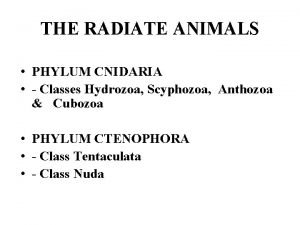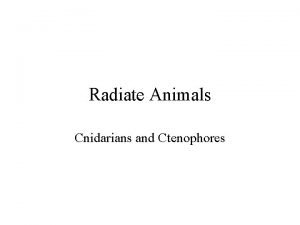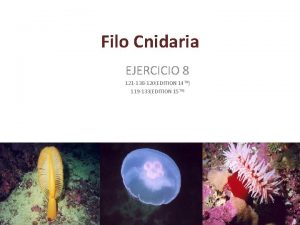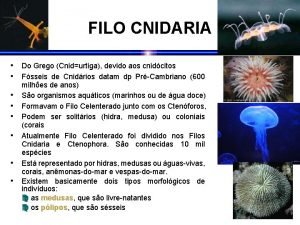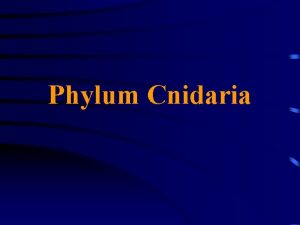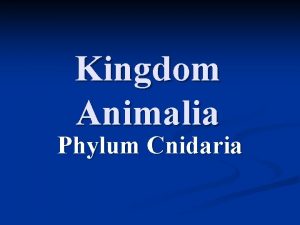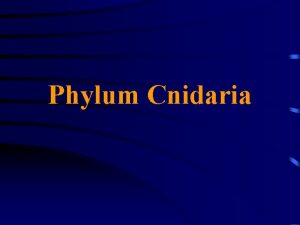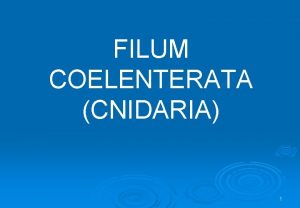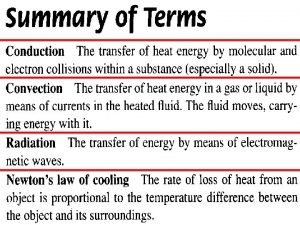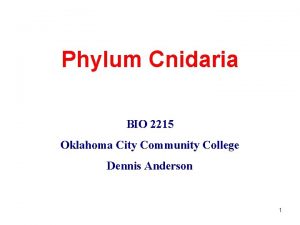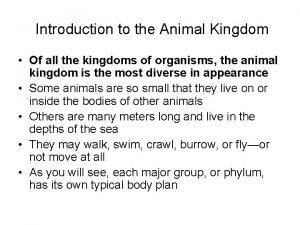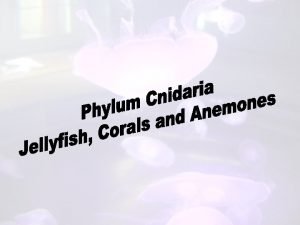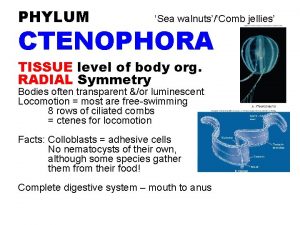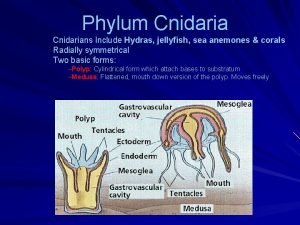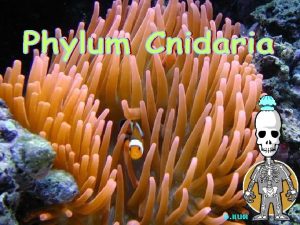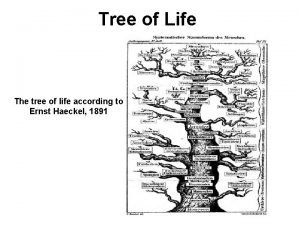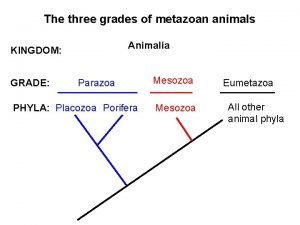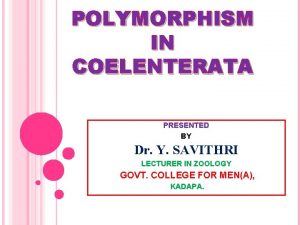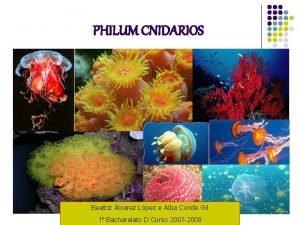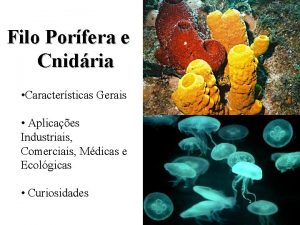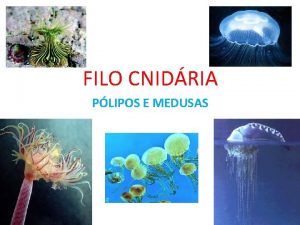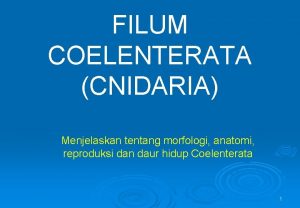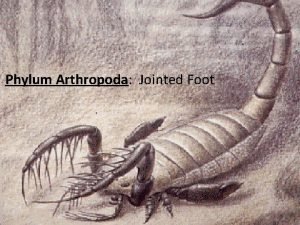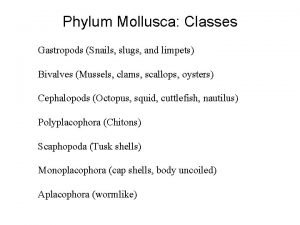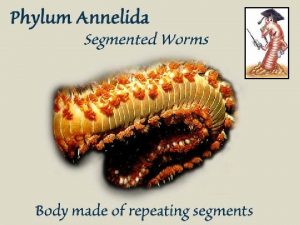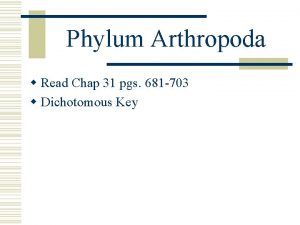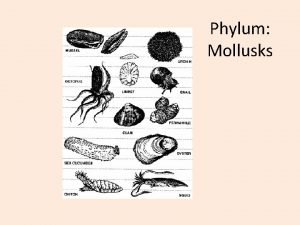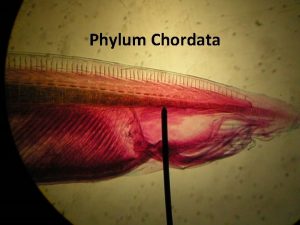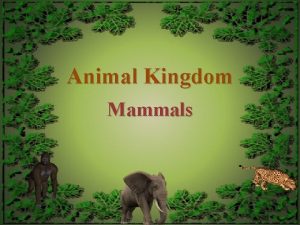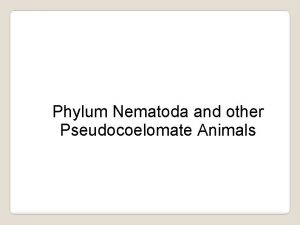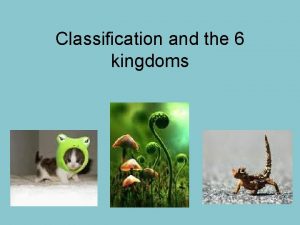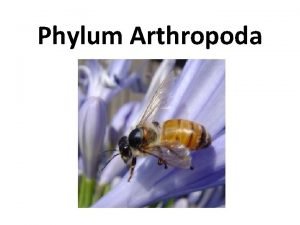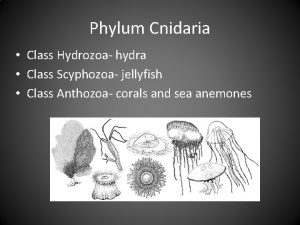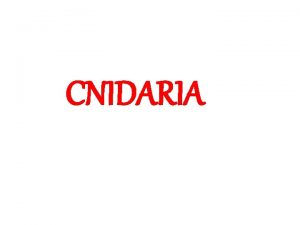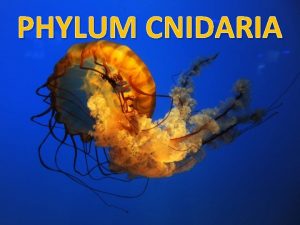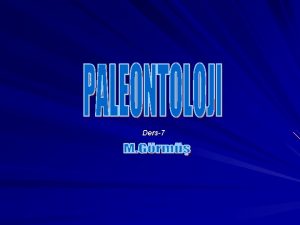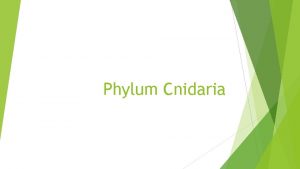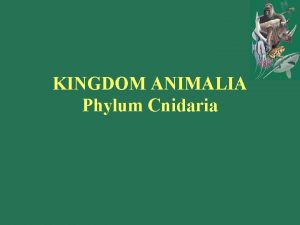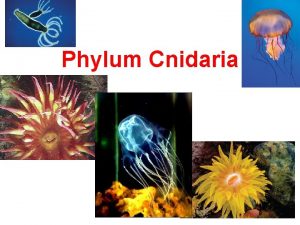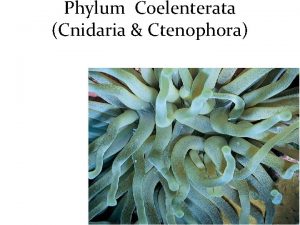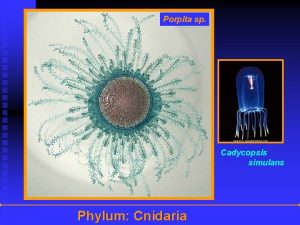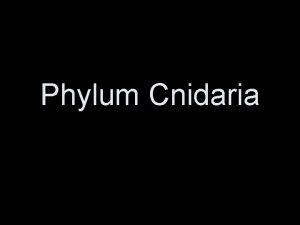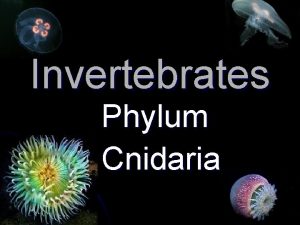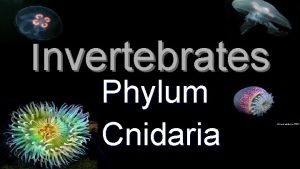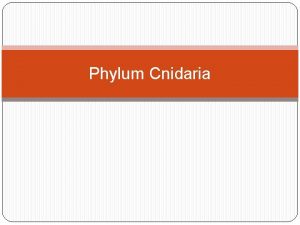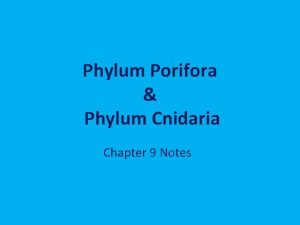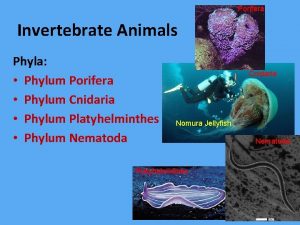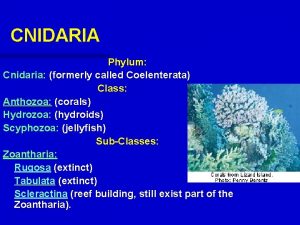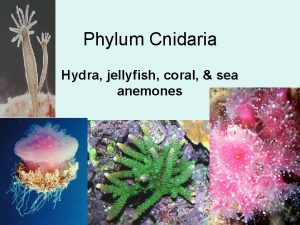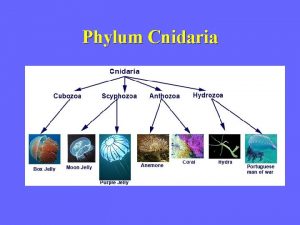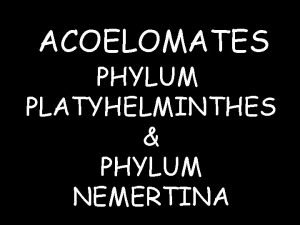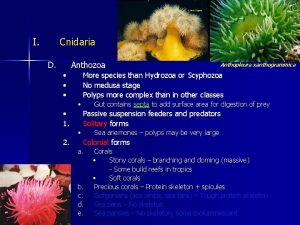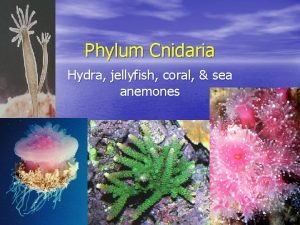THE RADIATE ANIMALS PHYLUM CNIDARIA Classes Hydrozoa Scyphozoa


































































- Slides: 66

THE RADIATE ANIMALS • PHYLUM CNIDARIA • - Classes Hydrozoa, Scyphozoa, Anthozoa & Cubozoa • PHYLUM CTENOPHORA • - Class Tentaculata • - Class Nuda

CLASSES OF PHYLUM CNIDARIA • CLASS HYDROZOA eg Hydra, Obelia • CLASS SCYPHOZOA eg Aurelia aurita (Jelly fish) • CLASS ANTHOZOA eg Sea anemones, Corals • CLASS CUBOZOA eg Tripedalia cystophora, Sea wasp

GENERAL CHARACTERISTICS OF PHYLUM CNIDARIA • Have simplest degree of structural and functional organization • Exclusively marine, few sp in fresh water • Are acoelomates (lack coelom) • Radially symmetrical • There is diversity of body types found among the members of this phylum. • Has 2 distinct layers ie Ectoderm and Endoderm

BODY CAVITY DIVERSITY(FROM ACOELOMATES THROUGH PSEUDOCOELOMATES TO COELOMATES)

WHY ARE CNIDARIAN ACOELOMATES? • Coelom (also called the body cavity) cavity within the body of all animals higher than the coel enterates and certain primitive worms. • Formed by the splitting of the embryonic mesoderm into two layers. • In mammals it forms the peritoneal, pleural, and pericard ial cavities. • Cnidarian lacks this quality & are therefore Acoelomates • • In Pseudocoelomates, body cavity is incompletely lined by mesoderm eg in Rotifera & Nematoda. Coelomates begin from Mollusca then Annelids, Arthropods, Echinoderms & Chordates

GENERAL CHARACTERISTICS OF PHYLUM CNIDARIA • Tentacles around the mouth • Tissues level of organization • No choanocytes (flagellated collar cells of the sponges) • Alternation of generation with 2 morphologically distinct stages: • Polyp (sessile, remain attached, asexually reproducing form) • Medusa(motile, sexually reproducing form)

GENERAL CHARACTERISTICS OF PHYLUM CNIDARIA • No excretory or respiratory organs • Nerve net with symmetrical & asymmetrical synapses • Gastrovascular cavity used for both digestion and excretion. • Mesoglea (jelly-like substance between the two tissue layers (epidermis & gastrodermis) for support). • Hydostatic Skeleton - chitinous, calcerous, or protein.

• • • GENERAL CHARACTERISTICS OF PHYLUM CNIDARIA Radiata have only two embryonic tissue layers. Specifically, no mesoderm (the tissue that gives rise to structures, including muscles, in triploblastic organisms). Lack sophisticated movement seen in triploblastic organisms. Mouth: both ingestion & egestion- no anus Asexual reproduction by budding in polyps Sexually by gametes in all medusa & some polyps

DEFENSE IN CNIDARIANS • Cnidarians also have cnidocytes (specialized cells that function in defense & capture of prey) • Cnidocytes contain organelles called cnidae, which are able to evert (extend or retract). • Cnidae that sting are called nematocysts. • These nematocysts can immobilize fish for capture, and they can also be used for defense.

FEEDING MECHANISMS IN HYDROZOAN: HYDRA

THE HYDROZOA eg Hydra vulgaris • Class Hydrozoa includes hydras and the infamous Portuguese Man-of-War, an organism noted for its potent sting, in the medusa form. • Most Hydrozoans exist in the polyp and medusa forms. • For example, some hydrozoan eg Obelia exist as an asexually reproducing polyp that alternates with a sexually reproducing medusa form (see next slide).

Obelia life cycle

Dimorphism & Polymorphism in Cnidarians • A striking & puzzling feature • Dimorphism: existence in polyp & medusa • Polymorphism: colonies of some species have morphologically differing individuals each specialized for certain roles eg feeding, reproduction & defense.

Differences between Medusa & Polyp Medusa • • • • Sedentary or sessile life Non free swimming Has tubular body Simple body structure Velum absent Mouth is circular Mesoglea poorly developed Adapted for a floating life Free swimming Bell or umbrella-shaped Complex structure Velum present Mouth rectangular Mesoglea highly developed Note: Medusae possessing a velum are called veiled or craspedote medusae. Scyphomedusae have no velum & are acraspedote.

Polyp vs Medusa

Polyp vs Medusa

Class HYDROZOA eg Hydra

Body plan of Hydra

Body plan of Hydrozoa: Hydra

Body plan of Hydra • Epidermis consist: • Epitheliomuscular cells (can self-reproduce) for covering & muscular contraction • Interstitial cells: differentiate to form the cnidoblast, sex cells, buds, nerve cells. • Gland cells- located around the basal disc and mouth, secrete adhesive substance for attachment • Cnidocytes- contain nematocyst for catching prey • Sensory cells found around the mouth for detection of stiimuli • Nerve cells- synapse with sensory cells & other nerve cells

Body plan of Hydra • Gastrodermis consist: • Nutritive-muscular cells all tall. columnar, large and vacuolated with flagella at one end & microvilli at the other end • Interstitial cells: can transform to form other kind of cells when the need arises. • Gland cells- surround the mouth to aid feeding & digestion. • Mesoglea lies btw the epidermis & dermis and act like a type of elastic skeleton

Biology of Hydra: Hydrozoans • May be solitary or colonial • Found in freshwater • Hydra, unlike other hydrozoa exist as solitary(no medusa or colonial forms). • Cylindrical body shape • Body size depends on level of contraction and extension.

MOVEMENT OF HYDRA • • Somersaulting- Can be found hanging downward Walking Looping Floating Climbing Gliding Swimming

Feeding &Nutrition In Hydra • Use Tentacles to capture & direct the food • Exclusively carnivorous feeds on cylops, annelids, crustaceans, insect larvae. • Digestion in enteron (gastrovascular cavity)& is both • Extracellularly- the prey is killed by the action of digestive enzymes from gland cells of gastodermis • Intracellularly- occur in the gastrovascular cavity

Feeding & Nutrition in Hydra cont’d • Tentacles have many cnidoblasts in them for capturing prey • Nematocysts: Immobilize & paralyze the prey • Inside the gastrovascular cavity, gland cells secrete enzyme to digest the food. • Egestion via the mouth.

Reproduction in Hydrozoa: Hydra • Mostly dioecious(male & female separate) • Reproduce both sexually & asexually by budding. Has power of regeneration • Zygote undergo holoblastic(complete) cleavage to form the blastula. • Cleavage is indeterminate(regulative) • Fertilization: Cyst formed around the embryo which break loose from parent to form the young hydra.

BIOLOGY OF OBELIA • Unlike Hydra, has both colonial & medusa form • It’s a plant-like Hydrozoa • Whitish in colour under microscope • Largely carnivorous • Use tentacles to capture prey • Digestion both extra & intracellular

BIOLOGY OF OBELIA • Dioecious • Fertilization is external • Mouth open into manubrium • Zygote forms planular larva • Statocyst are gravity receptor for maintenance of balance

The life cycle of Obelia, an Hydrozoan

Classification & Diversity of Hydrozoa • Order Hydroida eg Hydra • Polyploid stage predominant, medusa short-lived or absent, sense organ exclusively ectodermal • Order Trachylina eg Craspedacusta • Polyploid stage redused or absent, medusa large, dominant, sense organs endodermal • Order Hydrocorallina eg Millepora • fixed, colonial polyploid in which the coenosarc secretes Ca. CO 3, polyps is dimorphic with slender dactylozoids and short plump gastrozoids

Body plan of Scyphozoa: Aurelia aurita

Life Cycle of Jelly fish- Aurelia aurita

CLASS SCYPHOZOA Jellyfish eg • a. k. a cup-animals with umbrella or bowlshaped • May attain a bell diameter of more than 2 m • Most scyphozoans range from 2 to 40 cm in diameter • May be colourless, orange or blue • Exists predominantly in the medusa form • Mesoglea unusually thick giving the bell a fairly firmed consistency

BIOLOGY OF CLASS SCYPHOZOA eg Jellyfishes • Predominantly Medusa, polyp form occurs only as small larva during life cycle stage. • Thaumatosyphus hexaradiatus are unusual member because medusa are sessile, attached to seaweed • Movement is by rhythmical pulsation of the umbrella • Tentacles may be few or short as in Aurelia aurita or long as in Cyanea

BIOLOGY OF CLASS SCYPHOZOA eg Jellyfishes • • • Aurelia aurita is common member No velum or nerve rings Oral arms bears the nematocysts Have sense organ called rhopalium Each rhopalium has two olfactory pits Nervous system has a nerve net with subumbrella net that control bell pulsations • The nerve net is concentrated to form ganglia at the base of rhopalia • Tentaculocyst is the organ of balance

BIOLOGY OF CLASS SCYPHOZOA eg Jellyfishes • Sexes separate • Sperm carried by ciliary current into gastric pouch of female • Internal fertilization • Reproduction& Life cycle: The medusa sperm + egg = Zygote • Ciliated Planular larva emerge = Scyphystoma (hydra-like form)= Strobila = Ephyra to adult.

Classification & Diversity of Scyphozoa • Order Stauromedusae eg Lucernaria • Bell, goblet or trumpet shaped, sessile attached by an aboral stalk, no marginal sense organ or tentaculocyst. • Order Coronatae eg Periphyla • Bell conical shaped, divided by a deep circular coronary groove, tentacles long, borne on pedalia • Order Discomedusae eg Aurelia, Pelagia • Flat saucer or disc-like umbrella, 8 tentaculocysts present, square-shaped mouth extending into 4 long oral arms.

Class: Anthozoa Sea anemone

CLASS ANTHOZOA • Eg sea anemones, corals , and sea fans. • Anthozoans are all polyps, no medusa ie Not Dimophic • Symbioses between reef-building corals and the dinoflagellates. • In these relationships, corals provide housing and protection for the protists, and the dinoflagellates provide food for the corals. • Members of all of the Cnidarian classes can respond to external stimuli and can use stinging nematocysts for prey capture and defense.

Anthozoa characteristics • Flower-shaped, body structure more complex than Hydrozoans • Exclusively polyploid, no medusa • Most advanced of all marine Cnidarian • Mouth lead to pharynx • Gastrovascular cavity subdivided by septa, or mesenteries partioned into chamber • Mesoglea stout with cells and fibres • Skeleton secreted in the form of coral • Nematoblast found in the body layers

Life Cycle of Anthozoa- Sea anemone

Biology of Anthozoans • Feeding • Similar to Hydra polyp • Aided with tentacles, cnidoblast and nematocyst. • Pharynx lined with lateral ciliated grooves • Movement by rhythmic contraction of muscles, mesoglea and water in gastric cavity

Biology of Anthozoans eg Sea anemones • Move by gliding slowly along the substrate on their pedal disc • Are carnivorous • Can expand & stretch their tentacles to catch the prey • Nematocysts immobilizes the prey • Pharynx with ciliated grooves: siphonoglyps • When disturbed, can contract & withdraw their tentacles and oral discs.

Biology of Anthozoans eg Sea anemones • Reproduction • Sexes are separate • Gonads borne on the margin of septa/mesenteries • Reproduction by sexual & asexual means • Asexual reproduction can occur by pedal laceration or at times budding • Fertilization occurs in enteron or externally: Planular larva emerge

Biology of Anthozoans eg Sea anemones • Oral end is an expanded oral disc • The mouth is often elongated with a ciliated groove (siphonoglyph) at one or both ends. • Gastrovascular cavity is sub-divided by 8 or more septa or mesenteries • Mesenteries with nematocysts and gastrodermal gonads.

Classification & Diversity of Anthozoa • Order Stolonifera eg Clavularia • Polyp arising independently from a creeping mat or stolon, skeleton of calcerous tubes or separate calcerous spicules or absent. • Order Telestacea eg Teleston • Lateral polyps on simple or branch stems arising from a creeping base, skeleton of calcerous spicules or absent. • Order Coenothecalia eg Heliopora • Polyploid embedded & connected by solenial tubes, skeleton massive, calcerous & blue green from iron salts.

Diversity in forms • HYDROZOA • Life history features both Polyp and Medusa stages, Mesoglea non cellular • SCYPHOZOA • True Jellyfishes have conspicuous medusoid form, Polyploid larva stage, Mesoglea thickened with fibres and cells • ANTHOZOA • Sea anemones, coral are all polyps, Mesoglea stout with fibres and cells

CHARACTERISTIC FEATURES OF PHYLUM CTENOPHORA • Biradial symmetry • Ellipsoidal or Spherical in shape with radially arranged rows of comb plates for swimming. • Nematocysts absent & replaced by Colloblasts • No polymorphism or dimorphism • Mouth, pharynx, stomach and anus present. • Reproductive stage involve free swimming cydippid larva

CLASS CUBOZOA • • • Most recently classified Exist as both Polyp & Medusa is the predominant form of this class Cubozoa medusa may be about 25 cm tall Medusa are stronger swimmer and voracious predator • Base of each tentacle form pedalium • Tentacle(s) present in each corner of umbrella margin

Class Cubozoa • • • Medusa dominant Polyp state develop directly to medusa Bell margin with velarium Tetramerous (four part radial symmetry) Bell may be cube or square--shaped with tentacles arising from each corner. • Gonads are endothermal (found in the gatrodermis) • Specialized sense organ called rhopalium

CLASS CUBOZOA • Class Cubozoa are the box jellies, which have a box-shaped medusa form. • Some species in this group are among the most venomous organisms in the world • Their stings can be fatal to humans

Structure of Class Cubozoa

Life Cycle of Cubozoa

SIMILARITIES OF CNIDARIA WITH CTENOPHORA • Radial symmetry • Well developed gelatinous collenchyme • No coelom cavity • No organ systems • Diffuse nerve plexus

Differences between Cnidarians & Ctenophores • • • No nematocysts Comb plates and colloblasts present Pharynx & Anal openings present No polymorphism or dimorphism Do not exist as colonies

Biology of representative type of Ctenophora: Class tentaculata • • Eg Plerobranchia is a representative of this grp Body size: 1. 5 to 2. 0 cm in diameter The oral pole bears the mouth The aboral pole bears the sensory organ called the Statocyst

Movement in Ctenophorans : The Comb Plates • Pleurobranchia has 8 equally spaced bands of comb rows on the body surface. • Each band consists of transverse plates of long fused cilia called the Comb plates • Cilia beating on the comb plates propels the animal around (movement). • The beat starts from aboral end to the oral aiding swimming. • All the 8 combs beat in unison. • Backward movement possible

Comb plates of Ctenophora

Ctenophora body plan

Ctenophora comb plate

Tentacles of Ctenophora • Has 2 long, solid & extensive tentacles • May be about 15 cm long when fully extended • The tentacle surface bear colloblasts (glue cells). • The colloblasts secrete substances to catch and hold the prey

Body wall of Ctenophora • Collenchyme lies between epidermis and gastrodermis • It fills most part of the interior wall of Ctenophores • Contain muscle fibres and amoeboid cells

Digestion and Feeding in Ctenophora • Feed on plankton such as copepods • Gastrovascular cavity consists of mouth, pharynx, stomach. • Gastrovascular canal branches to the comb plates. • Two blind canals terminate near the mouth. • Aboral canal ends in 2 anal canals

Nervous system in Ctenophorans • Similar to Cnidarians • The sense organ is located at the aboral pole( statocyst). • No central coordination as found in higher animals. • A calcareous statolith • The epidermis bears abundant sensory cells • Sensitive to chemical & other stimuli

Reproduction & Development in Ctenophorans • All monoecious (male & female organs in one animal) • Gonads located on the lining of gastrovascular canal under the comb plates. • Cleavage is determinate • Fertilization: free swimming Cydippid larva • Cydippid larva develops directly to an adult

Thank you for Listening Dr. O. A. , IYIOLA
 Scyphozoa
Scyphozoa Octomerous
Octomerous Cnidaria
Cnidaria Filo cnidaria classes
Filo cnidaria classes Phylum cnidaria general characteristics
Phylum cnidaria general characteristics Coral phylum
Coral phylum Cnidaria pronounce
Cnidaria pronounce Cnidaria characteristics
Cnidaria characteristics General characteristics of cnidaria
General characteristics of cnidaria Phylum cnidaria digestive system
Phylum cnidaria digestive system Class of phylum coelenterata
Class of phylum coelenterata Figure 15-2 is a longitudinal section of a kidney
Figure 15-2 is a longitudinal section of a kidney Objects that radiate relatively well
Objects that radiate relatively well Minor calyx
Minor calyx Thermal expansion in liquids
Thermal expansion in liquids Efferent arteriole
Efferent arteriole Anothozoa
Anothozoa Pada coelenterata klas yang tidak ada bentuk medusa adalah
Pada coelenterata klas yang tidak ada bentuk medusa adalah Radial symmetry examples
Radial symmetry examples Sea jellies
Sea jellies Cnidaria class
Cnidaria class Jellyfish anatomy
Jellyfish anatomy Classe e subclasse de em
Classe e subclasse de em Pre ap classes vs regular classes
Pre ap classes vs regular classes Anthozoa
Anthozoa Anthozoa life cycle
Anthozoa life cycle Ocelli
Ocelli Skeletozooid
Skeletozooid Hydrozoa exemplos
Hydrozoa exemplos Classe hydrozoa
Classe hydrozoa Medusas mar menor
Medusas mar menor Reproduksi filum cnidaria
Reproduksi filum cnidaria Classes in phylum arthropoda
Classes in phylum arthropoda One of the representatives of phylum arthropoda is
One of the representatives of phylum arthropoda is Classes of phylum mollusca
Classes of phylum mollusca Earthworm coelom
Earthworm coelom Classes in phylum arthropoda
Classes in phylum arthropoda Three kinds of mollusks
Three kinds of mollusks Platyhelminthes notochord
Platyhelminthes notochord Animal con t
Animal con t Roundworm phylum name
Roundworm phylum name Kingdoms taxonomy
Kingdoms taxonomy What is the largest phylum of animals
What is the largest phylum of animals Detritus food chain
Detritus food chain Kyle douglass
Kyle douglass Animals that eat both plants and animals
Animals that eat both plants and animals Animals that eat both plants and animals
Animals that eat both plants and animals Voi kéo gỗ như thế nào
Voi kéo gỗ như thế nào V. c c
V. c c Thể thơ truyền thống
Thể thơ truyền thống Sự nuôi và dạy con của hươu
Sự nuôi và dạy con của hươu Thế nào là hệ số cao nhất
Thế nào là hệ số cao nhất đại từ thay thế
đại từ thay thế Diễn thế sinh thái là
Diễn thế sinh thái là Lp html
Lp html Vẽ hình chiếu vuông góc của vật thể sau
Vẽ hình chiếu vuông góc của vật thể sau Làm thế nào để 102-1=99
Làm thế nào để 102-1=99 Thế nào là mạng điện lắp đặt kiểu nổi
Thế nào là mạng điện lắp đặt kiểu nổi Lời thề hippocrates
Lời thề hippocrates Mật thư tọa độ 5x5
Mật thư tọa độ 5x5 Thang điểm glasgow
Thang điểm glasgow Vẽ hình chiếu đứng bằng cạnh của vật thể
Vẽ hình chiếu đứng bằng cạnh của vật thể Quá trình desamine hóa có thể tạo ra
Quá trình desamine hóa có thể tạo ra Sự nuôi và dạy con của hươu
Sự nuôi và dạy con của hươu Các châu lục và đại dương trên thế giới
Các châu lục và đại dương trên thế giới Dạng đột biến một nhiễm là
Dạng đột biến một nhiễm là Bổ thể
Bổ thể
